底盘维护和保养
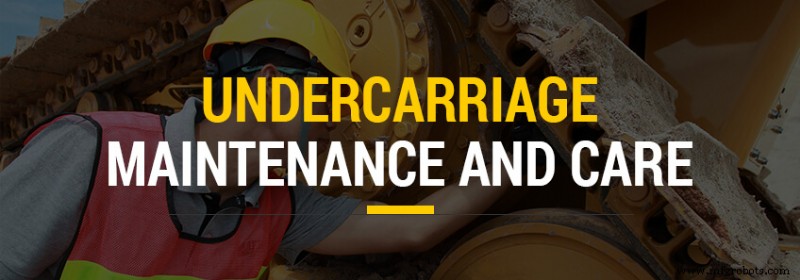
如果您拥有或操作依赖于轨道的重型设备,您就知道您的起落架是设备的关键部分。爬行设备很复杂,它可以承受恶劣和沉重的条件。但是,没有任何设备可以永远使用。您花在底盘维护和保养上的努力将在延长部件寿命和持续工作时间方面获得巨大回报。
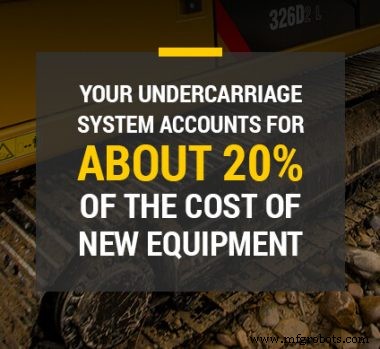 在轨道上爬行的重型设备是一项巨大而重要的投资。您的起落架系统约占新设备成本的 20%。相比之下,您的起落架约占维护预算的 50%。为了充分利用您的设备投资,适当的起落架预防性维护至关重要。
在轨道上爬行的重型设备是一项巨大而重要的投资。您的起落架系统约占新设备成本的 20%。相比之下,您的起落架约占维护预算的 50%。为了充分利用您的设备投资,适当的起落架预防性维护至关重要。
起落架维护比执行常规起落架检查更多。两个主要的起落架管理原则是保持清洁和保持适当的张力。除了这些关键点之外,随着时间的推移,还有许多因素会影响设备的磨损,包括您的应用、地形、操作员技术以及为您的工作使用正确的轨道。
为您的工作选择正确的轨道
土方设备技术不断进步和发展。今天的设备比过去的挖掘机、推土机和紧凑型履带装载机更加可靠和耐用。现在,您可以选择多种轨道选项,而成功运营的关键是为您的独特需求选择合适的选项。
没有通用轨道这样的东西,因为您操作设备的条件可能会有很大差异。您将体验到从柔软的沙子或淤泥到咀嚼履带的岩石和拆除碎片的一切。
工程师设计设备轨道以有效转移重量。与轮式设备相比,配备履带式设备的占地面积或地面压力要小得多,而且它们也具有更大的牵引力。但是,某些表面上的履带可能很硬,这就是为什么像 Caterpillar 这样的领先设备制造商允许您从以下两种履带材料中进行选择:
- 钢轨: 大多数大型设备,如液压挖掘机和推土机,都使用钢履带来实现推进、牵引和稳定性。就耐用性而言,金属轨道无可替代。钢坚固耐用。但是,钢轨会撕裂您的工作表面并造成损坏。带有钢制履带齿的金属垫可以切入地面,这样它们就可以推动您的设备并让它发挥设计的作用。如果您有更敏感的应用,您可能需要考虑橡胶替代品。
- 橡胶履带: 您很少会在大型设备上找到橡胶履带。橡胶是一种高度柔韧的材料,必要时它会很坚韧。但是,您可以期望橡胶履带支持的内容是有限的。如果您在草皮等柔软的地面或混凝土等成品表面上工作,您最好选择橡胶履带。你仍然会有很好的支持和控制,但你不会那么容易受到附带损害。橡胶履带非常适合需要轻量化的小型挖掘机和紧凑型履带装载机。
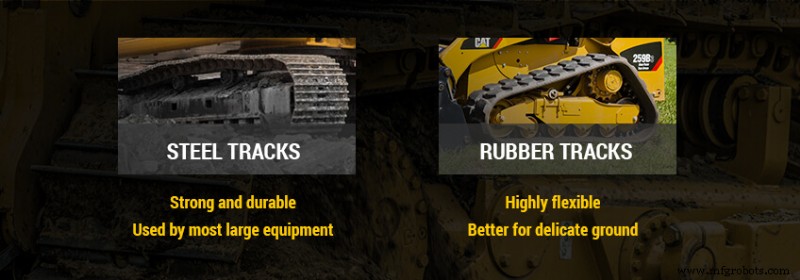
无论你是在橡胶还是钢上跑步,你仍然会拥有至关重要的您需要的起落架支撑。您的起落架组件可让您爬行、转动和保持直立。它们还可以让您的轨道对齐和适当的张力平衡,让您的设备正常工作。
虽然您的钢制或橡胶履带在其设计使用寿命内可能是可靠的,但您的起落架总是很脆弱。起落架是一个复杂的运动部件系统,需要特别注意防止故障。起落架故障可能是灾难性的,而且维修费用非常昂贵。
防止故障是您的起落架维护计划的全部内容。您必须密切注意底盘部件以及轨道告诉您的内容。您计划的一个重要部分是了解影响起落架磨损的因素以及您可以采取哪些措施来防止过早磨损。
影响底盘磨损的因素
随着时间的推移,所有底盘部件都会自然磨损,并且它们的使用寿命有限。
底盘磨损没有具体的时间限制。尽管您以工作时间来衡量使用寿命,但对于设备的起落架可以使用多长时间并没有固定的比率。组件的使用寿命很大程度上取决于您在工作现场会遇到的各种因素。以下是影响底盘磨损的主要因素:
- 应用: 这个因素是指您使用设备完成的工作类型。应用程序对施加在您的零件上的应力和应变有巨大的影响。典型的现场应用包括挖掘或挖沟、推土或推土、翻土、装载、搬运和平整。某些应用程序比其他应用程序对您的起落架施加更大的压力。关键因素是通过驱动系统从动力组件传递的扭矩。通常,这项工作所需的扭矩越大,您的起落架就会受到越多的磨损。
- 地形: 你很少能控制你的设备面对的地形。通常,您的设备可以改变地形。它必须在预设条件下工作,其中一些条件可以测试您的起落架限制。起落架上的地形磨损来自于在山坡、斜坡、顶部和凹陷处工作。真正磨损您的组件的是您的底盘系统在不断变化的地形中所经历的阻力。
- 脚下: 除了具有挑战性的地形外,您的起落架所经历的脚下条件也是如此。您的曲目从磨蚀性岩石和粗糙碎片中脱颖而出。然后,您的履带会将脚下的材料传输到您的起落架中,从而造成磨损。像沙子这样的脚下条件在您的轨道上可能看起来柔软而轻松,无论它们是橡胶还是钢。然而,沙子的磨蚀性很强,它会在移动的底盘部件上磨掉,导致高磨损和缩短寿命。从脚下威胁中幸存下来的诀窍是不断清洁。
- 操作: 应用、地形和脚下条件并不是对您的起落架的唯一威胁。大量磨损来自设备的操作方式。过度操作是影响底盘磨损的一个重要因素。
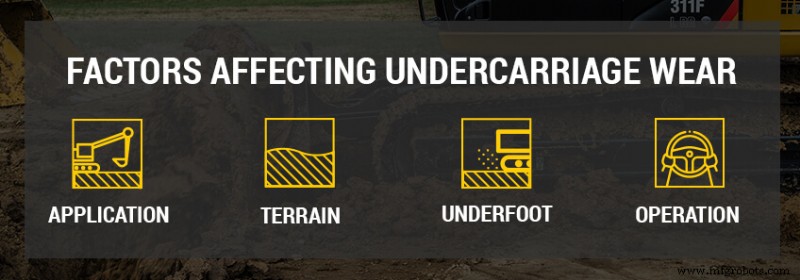
您可以通过培训操作员负责任地运行设备来轻松防止不必要的底盘磨损。您还可以通过监控操作员来最大限度地减少他们的磨损。仅此一项干预就可以为您节省大量的底盘保养和维修费用。
正确的轨道设备操作
大多数设备操作员不打算造成伤害。操作员的伤害通常来自经验不足或缺乏适当的培训。您会发现操作员在磨损设备起落架时会犯的主要错误包括:
- 积极行动以快速完成工作
- 在现场条件或指定的速度限制下行驶速度过快
- 将挖掘力施加在后驱动链轮上,而不是前惰轮上
- 从设备一侧挖掘并在起落架上施加横向张力
- 在柔软的脚下和地形条件下打滑或打滑
- 在一个方向连续转动设备,而不是交替转动
- 不必要地倒车,这会对驱动器施加方向错误的力
- 在坡度和斜坡上作业,而不是平整设备以均衡受力
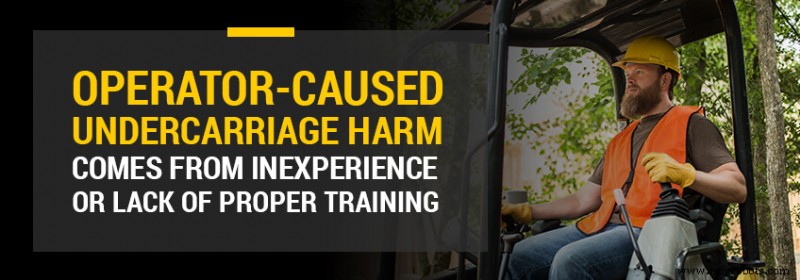
您的起落架的每一次运动都会导致部件磨损。但即使零件会磨损和更换,但这并不意味着您不能采取措施延长它们的使用寿命。您为培训操作员并让他们成为您的起落架维护计划的一部分所付出的努力将给您带来回报。您的员工可以采取的主要步骤之一是执行日常底盘检查。
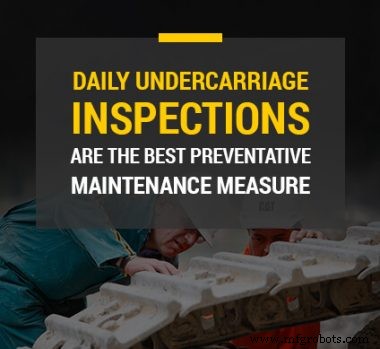 每日底盘检查
每日底盘检查
如果您的设备操作员在您的车队中有个人利益,他们更有可能正确对待它。他们会注意正确的操作程序,例如避免起落架上的侧向应力,以及不对后驱动器施加挖掘力。它们将以足够的速度行进以高效地工作,但速度又足够慢以减少组件的磨损。
您的操作员离您的设备最近,当问题开始发生时,他们是早期预警的绝佳来源。鼓励您的操作员立即报告潜在问题。他们通常通过每天的底盘检查发现问题。
执行日常底盘检查是您的团队可以采取的最佳预防性维护措施之一。检查不需要太多时间,但他们有长期的回报。以下是您在进行日常底盘检查时要检查的要点:
- 退后一步,环顾四周,找出任何不合适的地方。
- 在查看各个部件之前,绕着您的设备转一圈。
- 寻找漏油或任何可能滴落的不自然湿气。
- 进一步查看泄漏的密封件或损坏的润滑脂接头。
- 检查链轮是否有齿磨损和螺栓后退。
- 检查您的惰轮、导板、滚轮和连杆是否有松动或缺失的零件。
- 注意您的起落架框架是否有应力开裂迹象。
- 检查底盘导轨并寻找压痕磨损。
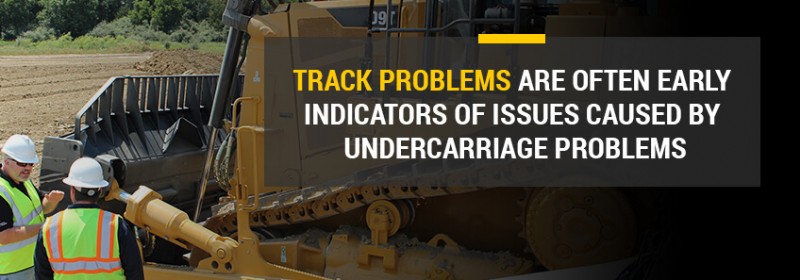
您的起落架并不是您设备中唯一需要进行日常检查的部分。您的足迹也很重要,需要密切关注。履带问题通常是由底盘问题引起的问题的早期迹象。以下是每天在您的轨道上检查的内容:
- 纠正任何破裂、破损或松动的鞋子,并立即更换丢失的鞋子。
- 检查履带张力并遵守设备手册中设置的公差。
- 注意显示向内或向外行驶趋势的轨道对齐。
- 检查前缘和后缘的鞋子磨损情况以及牵引杆的磨损情况。
- 启动您的设备并在监控性能的同时缓慢旋转每个轨道。
- 如果您有橡胶履带,请检查是否有任何开裂或磨损。
- 检查钢轨是否有腐蚀或金属疲劳。
您的履带会对您的整体底盘系统性能产生巨大影响。大多数设备制造商和运营商认为履带是与真正的底盘部件(如链轮、驱动器、连杆、滚子和惰轮)稍微分开的实体。履带和起落架组件在技术上都是独立的系统,但彼此相互支撑。
无论您使用的是橡胶履带还是钢履带,都需要进行日常检查和适当的维护。您的起落架需要低磨损和可自由移动的部件才能获得良好的性能,而这首先要确保您调整履带张力。
调整履带张力
拥有正确的履带张力对于底盘系统的持久使用寿命至关重要。轨道张力需要在不太紧和不太松之间取得完美平衡。这可能很难实现,适当的轨道张力取决于某些因素。
如果您的履带很紧,它们会给您的所有底盘部件带来不必要的阻力。起落架的每个移动和静止部分都会受到压力。这会导致早期磨损和昂贵的维修费用。
如果您的履带太松,它们也会对您的起落架造成压力。松散的轨道会漂移并失去对齐,给您的系统施加侧应力。与太紧一样,松散的履带会磨损您的起落架并且可能会花费您。
设置正确的轨道张力取决于多种因素。履带张力与具体设备设计、个别履带类型和实际工作条件有关。这些是影响轨道张力的主要因素:
- 曲目类型: Steel or rubber manufacturing materials
- Equipment size: Large hydraulic excavator or small multi terrain loader
- Underfoot conditions: Soft sand or hard rock terrain
- Environmental influences: High or low temperatures and seasonal variances
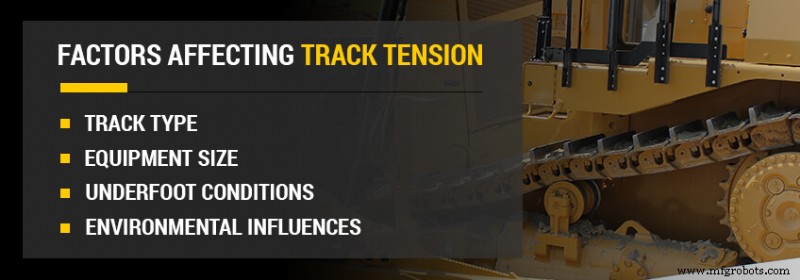
Setting your track tension to get the best performance from your undercarriage can be an art of its own. Track tension is equipment-specific but it has an important influence on your undercarriage wear. The best step you can take is referring to your original equipment manufacturer’s manual like those that come with your Cat
®
equipment.
You’ll likely come across the word “sag” when you’re investigating how to set your track tension. Sag is the dip or drop you’ll see in your track at the upper plane where it’s not affected by ground compression. Your manufacturer will have a sag guide table that gives ideal tolerances for track tension.
You’ll find a lot of variance in track tension tolerances. Big excavators with standard sprocket designs and large steel tracks have different sag rates than rubber-equipped compact track loaders with elevated sprocket designs. When in doubt about track tensions, always contact your equipment dealer for professional advice.
Professional advice from a reputable dealer will save you a lot of headaches when it comes to undercarriage issues. They know the tension tolerances needed for top performance and will always advise you of the most important rule in undercarriage maintenance — keep it clean.
Cleaning Undercarriages
Cleaning your undercarriage is the simplest and safest way to make your undercarriage last as long as possible. Your undercarriage is a complex system of moving parts that can break down when it gets too dirty. Regular cleaning is undercarriage management 101.
It might take a lot of effort to clean your undercarriage components properly, but it’s worth your time. What cleaning is necessary depends on what application you’ve put your tracked equipment through, what terrain you’ve operated it in and what underfoot conditions you’ve moved your tracks through. What’s deposited into your undercarriage assembly is a by-product of work. It’s also a mess that has to come out.
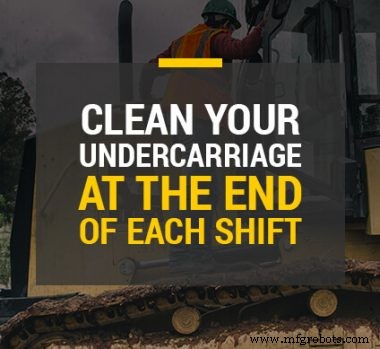 Cleaning your undercarriage is an ongoing event. It’s best to get it done and over with right at the end of each shift. It’s not wise to let a dirty undercarriage sit overnight. In warm weather, gunk can dry and harden. In cold times, it’ll freeze and bind. Either way, it’s going to be a lot harder to clean your undercarriage later than sooner.
Cleaning your undercarriage is an ongoing event. It’s best to get it done and over with right at the end of each shift. It’s not wise to let a dirty undercarriage sit overnight. In warm weather, gunk can dry and harden. In cold times, it’ll freeze and bind. Either way, it’s going to be a lot harder to clean your undercarriage later than sooner.
Dirty undercarriages lead to a number of problems over time. Built-up debris will jam your moving parts and can cause components to snap under protest. Grit also leads to abrasion and premature wear. You’ll also have lower fuel efficiency where there is resistance from clogged tracks and stuck undercarriage parts. Here are some undercarriage cleaning tips to help your preventative maintenance program:
- Use a power washer, if possible, to blast debris from undercarriage parts.
- Use a specially designed track spade to dig out rocks and mud clumps.
- Use a basic hose at the very least to wash components and free-up grit.
- Use compressed air to shoot into your undercarriage assembly.
- Use the track-spinning method to force materials from your equipment centrifugally.
Whatever undercarriage cleaning method you try, make sure you stick with it regularly. Clean undercarriages are long-living assemblies, and they’ll save you a lot of time and money. Cleaning is extremely important for your overall undercarriage preventive maintenance plan.
Track Size and Shoe Importance
It’s always important to bring up track and shoe size when talking about undercarriage maintenance. Having the proper track width and shoe size for your task has a big effect on performance. If your track and shoe combination is oversized, the unnecessary weight and bulk will wear your undercarriage components. If your track and shoe assembly is too small, your flotation rate will suffer, and so will your undercarriage.
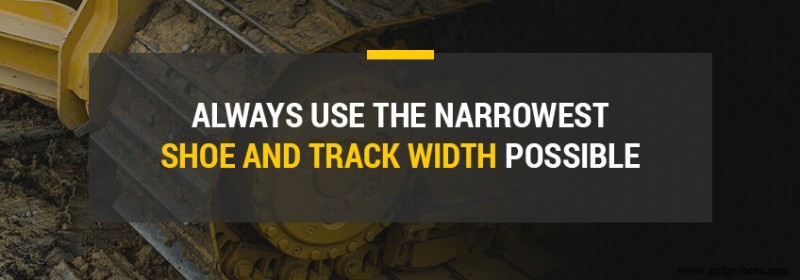
The rule to follow is always to use the narrowest shoe and track width possible. You still want adequate flotation for your terrain and underfoot conditions, but you don’t want to exceed the optimum rate. An oversized track and shoe assembly can cause these undercarriage issues:
- Increased sprocket and busing wear
- Increased wear on flanges, idlers, rollers and links
- Loose pins and shoe hardware
- Track joint life reduction
- Broken shoes and track with failed undercarriage components
Using proper-sized tracks and shoes is an important measure in the fight to keep your undercarriage alive as long as you can. So is keeping your undercarriage clean and always having the proper track tension adjusted for your application. Preventive maintenance is essential for several reasons.
Undercarriage Preventive Maintenance Importance
There are many steps in the undercarriage maintenance process that are essential for ensuring our equipment is at peak performance. Cleaning your undercarriage regularly and adjusting your track tension certainly vital. Lubricating moving parts and replacing components when it’s time are very important as well. Daily inspections also compete for top prevention priority.
Failing to maintain your equipment’s undercarriage is a guarantee to have your equipment fail early. Unfortunately, undercarriages are wear items on all equipment like dozers, excavators and track loaders. But they don’t have to wear out and fail any sooner than necessary.
Undercarriage failure costs are expensive. In addition to repair bills, equipment failures due to poor undercarriage maintenance cost you in job site downtime. They can also cost you in business reputation.
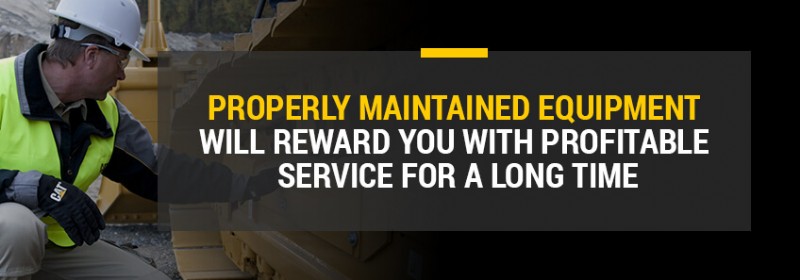
Your reputation, site time and bottom line don’t have to cost you due to undercarriage failure. If you properly maintain your tracked equipment, it will reward you with profitable service for a long time. Consider also partnering with an equipment dealer who knows the value you’ll get with an undercarriage preventive maintenance program.
Video Transcription
Hey, I’m Dave with today’s Quick Tip and I’m here to help you make the most of your investment.
Make inspecting your undercarriage a part of your daily routine.
Look for cracks and damage to the tracks.
Remove excess amounts of dirt and large debris from your undercarriage.
Concrete, rocks and even hardened mud or dirt can increase the fraction your track experiences which will cause wear and may even cause the track to fall off.
Manually extract large items and the occasional power washing will help keep your undercarriage in good shape.
You should also look for loose hardware and oil leaks.
Know the grease points on your specific model.
It is important to grease them daily to lubricate the bushings on your undercarriage frames.
Proper greasing also helps push dirt out.
Tracks should not be too loose or too tight.
Refer to your operation and maintenance manual on the proper tension test procedures for your machine’s specific undercarriage.
Different styles of undercarriage have different tensioning procedures.
The proper track tension will extend the life of your undercarriage.
So remember, for healthy machine undercarriages apply these three simple rules:keep it clean, keep it greased, and keep it tensioned.
Consult your operation and maintenance manuals for more information.
That’s been today’s Quick Tip. Thanks for watching.
Partner With MacAllister Machinery for Undercarriage Maintenance
At MacAllister Machinery, we know how valuable your tracked equipment is. We realize undercarriage maintenance and servicing account for a large chunk of your overall maintenance budget. We want to help you spread your business costs over a long time, and we know that proper undercarriage attention is vital to you.
If your run tracks in Indiana or Michigan’s lower peninsula, partner with MacAllister Machinery for long-term undercarriage management and care. We have the undercarriage service you need to keep your Cat tracks turning and making you a high return on your investment.
Contact MacAllister Machinery today for your undercarriage management solutions. Call us at (317) 545-2151 or contact us online.
设备保养维修


